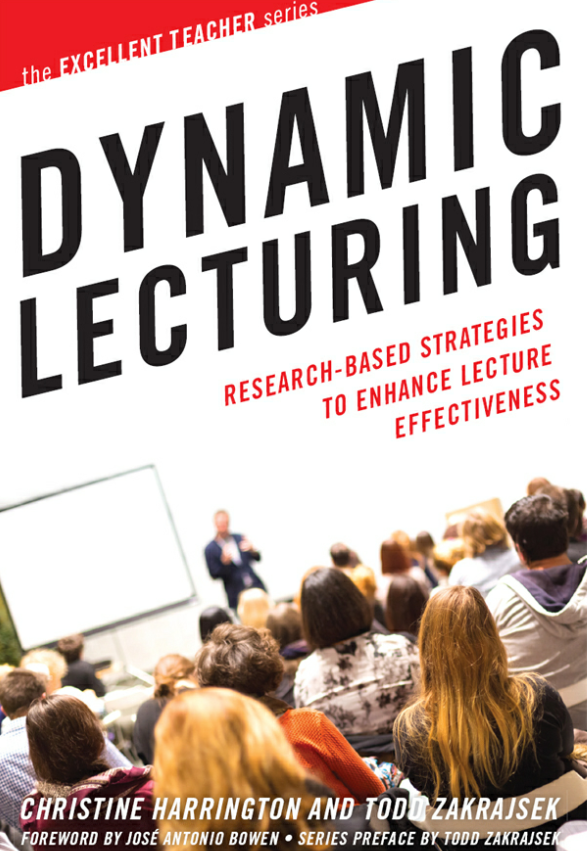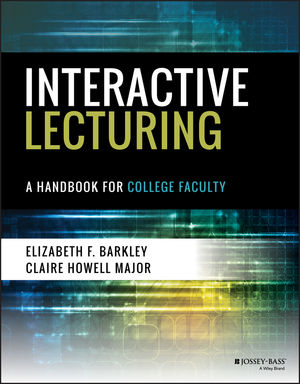
Anyone who follows the current pedagogical discussions in higher education has encountered the vilification of the lecture. It’s pretentious (the much-reviled stereotype of the sage on stage), it’s boring, it’s passive, it’s anti-learning.
It’s not too often that one comes across a research-based, full-throated defence of the lecture. Such is the book I want to recommend today: Dynamic Lecturing: Research-Based Strategies to Enhance Lecture Effectiveness (COD Library link).
The book argues that we don’t live in a binary world where lecture = bad, and active learning = good:
Lectures can have very powerful effects. It is actually very easy to demonstrate the strong potential of the lecture to teach an individual who is a novice in any field.
Harrington, Christine. Dynamic Lecturing (The Excellent Teacher Series) . Stylus Publishing. Kindle Edition.
The problem with discussion pitting lecture against active learning is that it is based on stereotypes of old, crusty professors delivering a monologue in the most boring fashion possible, while active learning is always assumed to be done well with fully engaged students who love every minute of it. These discussions remind me of the old PC v. MAC commercials.

Those discussions are not helpful. There are different types of lectures, just like there are different types of active learning. And there are effective and not so effective ways to do both or either.
And for those of us fretting about our current situation:
No significant differences were found between online or in-person lecture formats. In other words, students performed equally well on quizzes regardless of whether the lecture took place in the classroom or online. However, it should be noted that students indicated it was easier to attend to the content when attending an in-person lecture as compared to the online lecture (Jensen, 2011). Toto and Booth (2008) found that access to online mini lectures increased test performance.
Harrington, Christine. Dynamic Lecturing (The Excellent Teacher Series) . Stylus Publishing. Kindle Edition.
I have an upcoming post on these particular point, bu for now, lecturing online is fine as long as one follows best practice. And among best practices is the duration of the lectures. Mini-online lectures work.
One of the key points of the book is that research supports the idea the lecturing is efficient and effective for novice learners, who have very little foundational knowledge to rely on and need to get it. These are the types of students we teach, which is why the core of the curriculum is based on foundational courses. In a context of a lot of content and a limited amount of time, efficiency matters and lecturing reducing cognitive load. It makes therefore sense to adopt a gradual approach with more lecturing at the beginning of a term, where students don’t have a lot domain knowledge to rely on, and then, gradually, introduce alternatives to lecturing as the term goes on. What matters is the level of domain knowledge students have: novices benefit the most from the lecture, more advanced learners benefit the most from active learning.
One of the strong feature of the lecture is when it incorporates storytelling. Human beings love stories and stories are a central part of how we learn things. Stories are a good way to put abstract content in context. Moreover, you don’t have to be the one to tell the story. There are tons of good films out there that can do that job better than we can. This is the time for another shameless plug for my beloved Kanopy. Moreover, storytelling works just as well for novices and more advanced learners. The bottom line is that the decision to lecture or not lecture is not a matter of choosing evil versus good. It is choosing the best approach for certain types of students for certain types of contexts.
Another source of frustration in the discussions about the lecture is the reduction to a stereotype, as if there were only one way of lecturing. This one:
The book goes through different types of lectures, listing their pros and cons, based on what the research shows, because, yes, there are multiple ways of lecturing: discussion-based lectures (the Socratic model), visually-enhanced lectures, demonstrations and tutorials, and interactive lectures. The research shows that the most effective models are those that blend different types of content and activities within the lecture.

Speaking of interactive lecturing, now is a good time to plug Interactive Lecturing – A Handbook for College Faculty (COD Library link). This is a handbook, which means, this is not a book you read cover to cover and then let it sit on your shelf. You will find reason to go back to it over and over to retrieve the checklists, tips, and ideas provided in there.
I am personally a fan of interactive lecturing (although I also heavily use visually-enhanced lectures because I teach a data-heavy discipline). How does interactive lecturing work? You alternate lecturing segments (15-20 minutes) with activities in-between:
Interactive lecturing has long been shown to be very effective (Hake, 1998; Crouch & Mazur, 2001). The student has the opportunity to immediately practice, or implement, background knowledge just learned by listening to the expert lecture. Because the lecture is focused and brief, typically about 15 to 20 minutes, it is relatively easy to maintain students’ attention. When polling or other similar active strategies are used during the lecture portion, attention and engagement are even more likely.
Harrington, Christine. Dynamic Lecturing (The Excellent Teacher Series) . Stylus Publishing. Kindle Edition.
Shameless re-plug for Socrative or any other polling system. You can even poll in Blackboard Collaborate.
Whichever way one decides to lecture, there are ways to enhance its effectiveness:
Activating prior knowledge
This can be done through priming, pretesting, quick quizzing (Socrative, again), explicitly connecting upcoming content to prior content from the class, or, yes, mapping a reading outline, or a mini-lecture online before a face-to-face session.
Sustaining attention and scaffolding
Research shows that when challenges are too easy or too difficult, students get bored. So, scaffolding is a good way to sustain attention. Reducing the amount of lecturing as the term goes on is a form of scaffolding. The idea is to ensure that students get the key points that you are trying to convey. Scaffolding can also take the form of note-taking outlines (again, not the small version of slides + some limited note-taking space). We cannot assume that undergraduate students will “get it”, that is, figure out what the most important idea of a lecture (or a reading, for that matter) is. In fact, research shows this is one of their most challenging tasks. So, providing organizational tools will help.
Using multimedia and technology
This is pretty much self-explanatory. Nevertheless, having good images and good graphics and charts matters a lot to learning (as well as making those available after the lecture). Visuals can also be used to emphasize the key points you are trying to make.
Examples and case studies
Depending on what we teach, some of us may rely a lot on worked examples and demos, or the exploration of case studies. These are important not just to demonstrate skills, but also to give our students a sense of the potential complexities of the topics we are teaching.
Wrappers to reflect
As part of dynamic / interactive lecturing, it might be worthwhile to finish the sessions with a wrapper activity that allows students to reflect on the content to which they’ve just been exposed. There are lots of examples of reflective activities.
Retrieval practice
The non-lecturing segments can also be used for retrieval practice, both of the content under examination, but also previous content (interleaving FTW). Here as well, quizzing, polling of various kinds can trigger retrieval.
Questioning
Framing our lectures as trying to answer a question or questions is a good way to help identify the main points of a lecture and of giving students road map as to what we are trying to do. Depending on the complexity of the topic, you may not have a definite answer at the end but at least you’ve engaged your class in some exploration. The exploration per se may lead to a series of activities.
Dynamic Lecturing has a whole bunch of summary sheets and check lists to plan for interactive and blended lectures, as well as students survey to determine student engagement. It also provides an observation sheet for peer observation. Those are really useful resources.
Interactive Lecturing has even more since it is a handbook and it is a bit on the weighty side but it is full of resources as well.
I highly recommend both books.
Thanks for reading.
Christine


